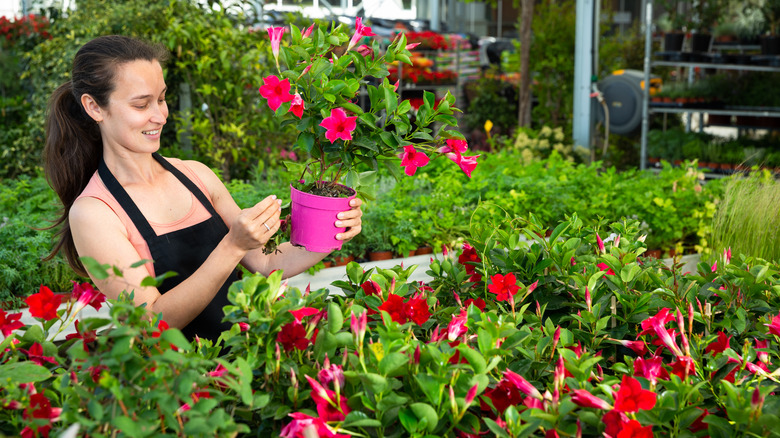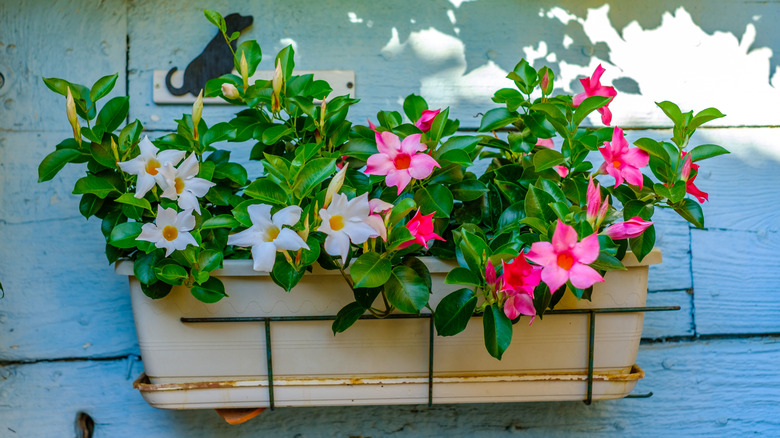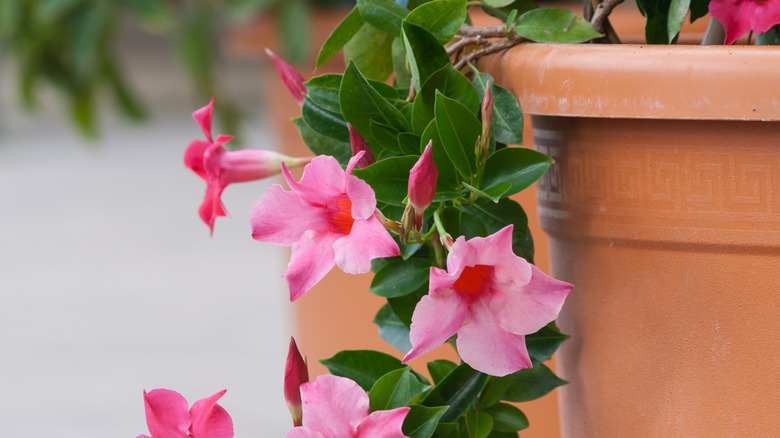How To Successfully Grow Mandevilla In Your Garden
Mandevilla is the name for a genus of flowers commonly known as rocktrumpet. This vine-growing flowering plant thrives in sub-tropical and tropical climates and rewards gardeners with both summer and fall blooms, as per Better Homes & Gardens. The genus includes a variety of species that grow to different heights, making this plant perfect for any outdoor space. You can find mandevilla varieties that reach a mere 3 feet when fully mature, while others shoot up to a whopping 20 feet.
You won't be limited to just one color scheme if you choose mandevilla for your garden — the blooms come in white, pink, and red, all of which are stunning against the evergreen blue-green foliage. Mandevilla petals are also unique in that they grow in a windmill shape with five petals on each flower head. The open interior of each bloom is a rich gold in color. Love to Know points out that the flowers grow between 2 and 4 inches wide while the leaves can reach 8 inches in length.
Mandevilla is relatively easy to grow and care for as long as the plant is provided with its preferred growing conditions, specifically in terms of temperature and climate. However, if you don't live in a sub-tropical or tropical region, you can still enjoy mandevilla planted in pots to be placed in your garden and brought indoors to survive the winter. Keep scrolling for everything you need to know about mandevilla care.
How to use mandevilla in the garden
With this flowering vine, your options are plenty when it comes to finding a good spot to plant mandevilla in your garden. Garden Gate suggests using mandevilla to make a statement in the entryway of your home if you have a small porch with pillars. You can plant your mandevilla using a bit of wire wrapped around the pillars to guide the vines upward as they grow, making them a focal point of your home's exterior. If you don't have pillars, the same idea works with stair banisters or other post-like features. Alternatively, you can place a trellis against an outside wall of your house and allow mandevilla to naturally decorate the exterior. If you have a fence or wall delineating your property, consider letting mandevilla add pops of color to an otherwise lifeless feature.
Since mandevilla grows well in pots and containers, you can also play with moving this plant to different locations around your garden. You might want to plant mandevilla in hanging baskets and string them up along porches or balconies. You can add a growing structure such as a small trellis or post to a container and let your mandevilla show off its height on decks and patios. Growing mandevilla in pots also allows you the flexibility to move the plant around your yard, depending on the time of year and your personal preferences.
How to grow mandevilla
When it comes to growing mandevilla, you will need to purchase a young starter plant from your local plant nursery. They are sold in small pots, ready to be transplanted to your garden or a larger container. SFGate explains that gardeners will need to have a trowel and nutrient-rich compost on hand to get started planting their mandevillas.
After finding a location for your mandevilla, get to work digging holes that measure the length of the root ball. The width of each hole should be twice that of the root ball. You will then layer a few inches of compost into the bottom of each hole. This next step is important to ensure that your mandevilla thrives in your garden — you will need to provide some type of climbing support, whether this be a post, trellis, or part of a fence. Make sure the support sits in the hole before you remove the mandevilla from the nursery growing pot and place it in the ground. Take a moment to gently pull apart the roots so they are spread out in the available space. Next, fill the hole in with soil until the root ball is covered, and pack it in on top. Finally, you'll want to generously water your new plant to encourage growth. As your mandevilla starts growing, note that you may need to tie the vines to the support structure until they develop a decent hold.
How to care for mandevilla
Whether mandevilla grows as a perennial or annual plant will depend on the region it's grown in. For those in USDA growing zones 10 and 11, mandevilla can be treated as a perennial and will not need any special care during the winter, as per The Spruce. Outside of these zones, however, mandevilla will need to be sheltered indoors through the winter before being returned to the garden for the next growing season. As a general rule of thumb, it should survive outdoors so long as temperatures stay above 50 degrees Fahrenheit.
In addition to proper temperature, it is important that your mandevilla receives enough sun exposure to allow its blooms to grow freely and healthily. It should be planted in an outdoor location that receives no less than six hours of full sunlight every day. Note that a full day of sunlight is not ideal during the hottest months of the year, as the leaves can end up burning.
When it comes to soil, you'll want to make sure the garden or potting soil you have on hand drains well and leans toward acidic. It should also contain a balance of organic matter. If it doesn't, adding a layer of compost should do the trick. You can also apply a liquid fertilizer twice a month. Mandevilla likes regular waterings but prefers that the soil stays on the dryer side. You can douse the leaves with a bit of water as well for added humidity.
Varieties of mandevilla
Mandevilla (common name: rocktrumpet) is native to the subtropical and tropical regions of the southern United States, Mexico, South America, and Central America, according to Ocean Home. The genus now includes over 100 species that vary in size and color, as per Home & Garden Information Center. You may still hear this plant called by its former scientific name, Dipladenia splendens; however, it was officially changed to mandevilla in the mid-1800s, according to SFGate. Its current name comes from the British plant explorer, Henry Mandeville, who saw it for the first time growing in Argentina and brought it back home with him.
Among the many varieties sold today, you will typically find blooms in shades of white, red, and pink. Garden Lovers Club outlines a number of popular varieties.
- Mandevilla 'Alice du Pont' is the most common variety of mandevilla. Its flowers are a gorgeous, deep-magenta color, and it grows to a staggering 20 feet when allowed to climb freely.
- Mandevilla 'Boliviensis' is white in color and reaches heights of up to 10 feet. It also displays a tendency to spread outward, reaching widths of around 6 feet.
- Mandevilla 'Sanderi' features soft-pink blooms that grow larger than other varieties at up to 12-inches in diameter.
- Mandevilla 'Sun Parasol' is another popular variety for those who enjoy red blooms and taller mandevillas. It grows up to 15 feet tall.
- Mandevilla 'Laxa' features classic white blooms that cluster in groups of around 15 per stem.
Is mandevilla toxic?
Plant Care Today reveals that mandevilla is a slightly toxic plant that should not be ingested. While ingestion is unlikely to be fatal, all parts of the plant, including the stems, flowers, leaves, and roots, can lead to stomach upset and discomfort along the digestive tract when consumed. Some individuals may experience more severe symptoms, such as vomiting or diarrhea, while others may simply find that the plant does not agree with them. Additionally, children and pets are at greater risk of mild toxication upon ingesting mandevilla due to their more sensitive digestive systems. If you or someone in your family experiences poisoning symptoms, contact your local emergency hospital or poison center immediately. The same goes for pets.
It should be noted that the sap of the mandevilla plant, which is white in appearance and sticky to the touch, can cause skin inflammation and rashes. Certain people or animals may also display an allergic reaction after eating the sap, including red bumps and open sores along the lips and in the mouth. It is best to wear gloves when handling the plant to avoid potential skin reactions.
To ensure that everyone in your family stays safe around mandevilla, you can put up physical barriers around the plant. You may also want to consider keeping mandevilla in hanging baskets or containers that can be placed out of reach until children are old enough to know not to eat the plant and pets are trained to stay away.
How to repot mandevilla
When grown in pots and containers, mandevilla will need to be transferred to a larger home every one to two years due to the fast-growing nature of its roots, as per Gardening Know How. There are various signs to look out for that will help you figure out whether it's time to purchase a larger pot. Well + Good points out that one sure sign is that the roots are emerging from the drainage holes at the base of the container. Another clue is that growth has slowed down or stalled and all other potential causes have been eliminated. Finally, you might notice that your mandevilla needs more water than usual, which signals that there are too many roots and not enough soil to hold adequate water.
You will want to wait until spring to repot your mandevilla, advises Gardening Know How. The new container you choose should only be one size larger than the current one and include drainage holes at the bottom. Pick up some high-quality potting soil and compost to mix together. Next, layer the base of the container with this mixture and transfer the mandevilla into the new pot. Fill in the rest of the container with potting soil and water the plant. You will also need to install the climbing structure with the mandevilla if you haven't already. It's important to keep your repotted mandevilla in a shadier spot for the first few days before returning it to full sun.
Mandevilla pests and diseases
Mandevilla is susceptible to certain pests and disease. Among the more common pests are mealybugs, which are insects that eat the leaves and stems of the plant, as per Garden Guides. They also like to lay their eggs along these same parts. In large quantities, they can severely damage the leaves and cause the plant to stop developing new growth. You can get rid of them with a spray pesticide. Scales also target mandevilla in high numbers. They damage the leaves of the plant, turning them yellow and, in some cases, eventually killing them. Horticultural oil is a great remedy for scale infestations. You should also dispose of infected individuals to prevent spread. Other insect predators include aphids, whiteflies, and mites.
As far as diseases go, mandevilla is susceptible to a number of fungal infections, as per Gardening Know How. You may find that your mandevilla comes down with a case of botrytis blight, which is a type of mold that leads to rot of the stems and roots. Leaf spots are another common affliction, which results in the browning and blackening of leaves until eventual death. Both botrytis blight and leaf spots can be treated with neem oil. Fusarium rot, southern blight, and crown galls are other common mandevilla diseases. Since most fungal infections are the result of soggy soil and poor air circulation, make sure you're not overwatering your mandevilla and that you prune it on a regular basis.







